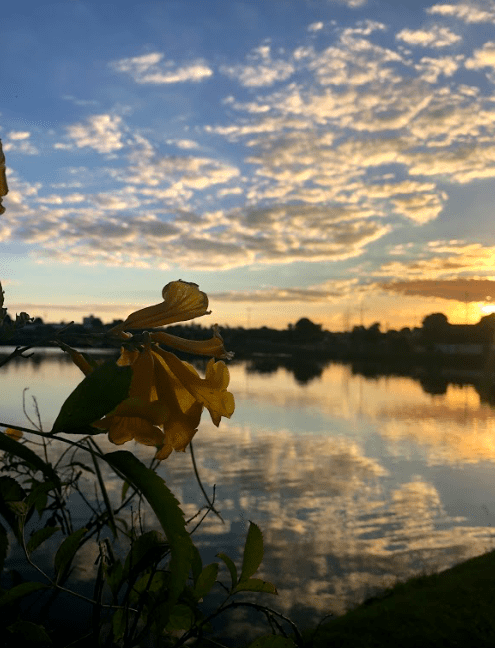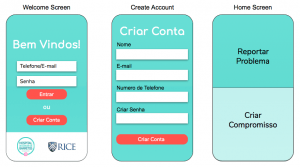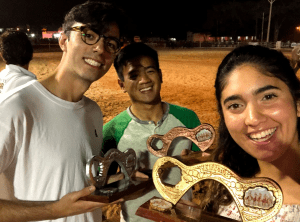It’s been a whole month since we arrived in Barretos. That’s right! Thirty-one days, Twenty-nine tours around various hospital departments, twenty-three meetings with doctors, and countless hours of tinkering and brainstorming in between. Pardon the cliche but I really cannot believe how quickly time is flying by! Before leaving for Barretos, I set out some resolutions for myself and, while some of them have been much harder to work on than I anticipated, I’m quite happy with the progress I’ve made. Before I get into my overall progress, I’d like to share some of my favorite memories from this past week!
Monday, June 24
Dr. Wilson Furlan was kind enough to give us a tour of the hospital’s Nuclear Medicine department. Nuclear medicine works by introducing radioactive isotopes like fluorine-18 or thallium-201 to the body for imaging procedures like positron emission tomographic (PET). The images produced by coupling the isotopes and medical imaging are VERY detailed and can be used to detect tumors or other abnormalities throughout the body. Going into this tour, I knew very little about the process of harnessing, preparing, and implementing the isotopes. However, we were able to see the entire process from the very start to finish.
It was cool to observe the meticulous preparation process. Nurses need to keep track of the radioactivity of the dose at the time of extraction and calculate, based on the half-life of the isotope, the time necessary for the dose to be administered. Diego and I were actually able to enter the room where the nurses created the doses. I was a bit overwhelmed by how many steps there were to the process but the nurses made it all seem so effortless as their hands fluttered from one instrument to another, checking the radioactivity levels, labeling samples, conducting quality checks, and crunching strings of numbers in their head with ease.
Wednesday, June 26
On Wednesday, we toured the Radiotherapy department. I’m about to geek out for a bit so bear with me. THIS DAY WAS AWESOME. Radiotherapy implements subatomic particles like positrons and electrons and gamma waves to target tumors throughout the body. While it is very effective in “killing” carcinogenic cells, it can also potentially harm healthy, neighboring organs –what doctors call “at-risk organs”.

Image created using ECLIPSE imaging software. The diagonal lines represent particular fields at various angles that can be used to target the spinal chord.
While I was excited by the sheer amount of machines scattered throughout the ward, I was more impressed by how advanced the software used by doctors and physicist. In order to protect the at-risk organs, physicists use specialized software for mapping and modeling the organ in question and calculate the optimal angle of exposure as well as the duration of the exposure. Although the dosage of radiotherapy is decided by a doctor, physicists work on a case by case basis to determine the specifics of the treatment in order to minimize risk. The program allows them to simulate various angles and durations of treatments in order to select the optimal plan. Once decided, the physicist logs the coordinates and other details into the computer, and sends the information to the treatment room where it can be downloaded to treat the patient. The software can also take the many medical images and create a custom, 3D model of the tumor in order to give doctors a better idea of what they’re up against.
Thursday, June 27
Rice 360 interns are expected to complete four main tasks while abroad, one of them is finding and completing a personal project. In order to identify a personal project, interns must conduct a period of needs finding in their communities and departments and choose a topic to address. Last year, Barretos intern Whitney Gartenberg created an automatic dosing machine for the nuclear department. If that isn’t impressive enough, Whitney designed, coded, and built the device and it’s wooden container before FEB 360 (the maker space here in Barretos) existed. Safe to say, the bar was set pretty high!
As we toured each department of the hospital, Diego and I accumulated a list of potential projects that we were interested in. We wanted to make sure that we chose a personal project that challenged our engineering skills (i.e. allowed us to pick up new skills to complement our existing knowledge), did not have an existing, “perfect” solution, and that could be completed within the remaining month. I found it a bit challenging to choose a single project idea. More often than not I want to overcommit and do it all! Each department we toured seemed so interesting and I had started to grow a bit attached to various ideas. However, after some deliberation, Diego and I decided to work on (*cue drum roll*) a mobile app for Dr. Denny, a dentist at the palliative care unit!
In Barretos, like in other rural communities throughout Latin America, it can be difficult for individuals to receive proper medical care due to financial and geographical barriers. We hope to address this problem by developing a mobile app. We intend to make the app super user friendly with few commands and prompts in order to appeal to an older audience. Patients will be prompted to create accounts on the app. Once signed in, a patient 100 km in Vista Alegre do Alto with mouth pain or discomfort can choose to either log their symptoms or call the hospital directly through the app. When describing their pain on the app, the user will be able to select from a list of symptoms, add their own notes, and take/upload images of their mouth. This information will then be sent directly to the dentist at Hospital de Amor for Dr. Denny and his team to analyze and decide whether the patient should or should not make the trip all the way to Barretos.
While I am beyond excited to take on this project, a part of me is a bit hesitant. We have very little experience coding (shoutout to Matlab!) and virtually zero experience creating apps –much less apps capable of transporting valuable information from patient to doctor! Regardless, I am hopeful and I believe that Diego and I, with the help of our engineering friends here and YouTube tutorials, will succeed!
Saturday, June 29
What a whirlwind to end a hectic week! We spent the morning relaxing, eating, and screaming at the local waterpark. After spoiling myself to pasteis de queijo and picanha, Diego and I decided to do a bit of team bonding and head over to the water slides. We grabbed a tandem floatie and headed for what looked like a massive, golden, U-shaped slide with a narrow drop right at the beginning. We mounted the floatie, looked down at the small pool of water just 60 meters below, and plummeted to the bottom. I began saying my goodbyes in my head until I realized we were safe and sound and I was actually having fun!! A couple more turns on the slide later and we were off to the wave pool (a personal favorite since I was little). The morning was filled with screams, laughs, and a lot of inhaled water. I want to go back!
The evening was even more interesting. We were invited to a Mule Rodeo. Yes. A rodeo for mules. Being from Texas, I hopped on the idea very quickly. The event was held in the center of Barretos in a country club of sorts. We arrived at the gates of the club and were welcomed by Natalia, one of the people in charge of organizing the Mule rodeo. She took us around the grounds. Vintage cars, leather boots, bell bottoms, saddles, the smell of buttery popcorn, and, of course, mules. It sounded like something straight out of a country song.
We stuck out like a sore thumb –me especially. To be fair, I may have brought it upon myself as I had the brilliant idea of wearing strappy sandals to an arena littered with dirt and mule poop. To make things a little more interesting, Natalia had a little surprise for us. We would be giving out the metals for first, second, and third place in front of real, professional, cowboys and cowgirls. The time for awards came and we were ushered onto the sandy arena (if my feet weren’t covered in sand already they sure were then) and we presented the trophies to the winners. Although I was caught a bit off guard, I loved the experience but I especially loved learning about what goes into training and preparing the mules from an expert like Natalia.
Personal Update
As I mentioned, I came to Brazil with a couple of goals in mind. While they sound quite intuitive, and maybe even a bit lackluster, I chose areas where I needed improvement or that pertained specifically to my experience abroad. I think some of my most fruitful moments of growth, personally, have been when I’ve been removed from my typical, physical environment which has made Barretos the perfect stage for my mini-metamorphosis (try saying that five times)! Because I’m a numbers gal I’m choosing to give myself a grade out of 5 (10 seemed a bit overdone). 1 means the resolution was put on the back burner and needs a bit more attention. 5 means I’m super comfortable in this regard.
1. Think outside the box. ( 2 / 5 )
It’s a bit tricky for me to give myself a grade for this one… On the one hand, we’ve been able to answer most, if not all, of doctors’ technological concerns and propose solutions with relative ease. However, I can’t help but question if the solutions we propose are truly “the best”. I know that engineering design is an iterative process and requires a couple hiccups here and there but I still feel like I’m pulling the same old tools. That is not to say that I’m not proud of the solutions we’ve proposed. I am! As we begin to develop our app idea and rebuild the WounderWoman device, I want to make a conscious effort to collaborate with engineering students here who, as I saw on my tour of the FEB 360, have a new perspective of engineering dilemmas.
2. Be comfortable getting uncomfortable. ( 3 / 5 )
Out of all of these goals, I feel as though I have improved in this regard the most. Like I said in my last blog post, I used to be terrified by the idea of being wrong and, as a result, wouldn’t let myself enjoy new learning experiences. It has been a long and hard process but I’ve slowly been making a mental shift to laugh and learn from my mistakes and not be so hard on myself. Thinking and communicating in a different language, watching my first surgery, dealing with my own ACL injury recovery process, introducing engineering strategies to real-world problems, and acquiring new skills (like CADing and app design) have each been difficult! There have definitely been times I felt frustrated not because of a lack of effort but a lack in performance and payoff. This quality is one that I really want to harness. Although the grade I’ve given myself is a bit underwhelming, I am proud of the progress I’ve made and continue to make but I know I still have a lot more in me 🙂
3. Fala mais Portugues! ( 4 / 5 )
My Portuguese speaking skills have improved SIGNIFICANTLY. At the very beginning of this experience, I couldn’t get out a complete sentence in Portuguese without stumbling over my words. I’d start expressing my thoughts, look around the room or at the doctors or nurses around me, feel embarrassed, tense up, and resort back to my Spanish. While I thought knowing Spanish would facilitate things, a surprisingly large fraction of the people here have asked us to opt for English because they cannot understand Spanish. Diego and I made sure to ask each doctor and nurse to speak to us in Portuguese during our departamental tours and meetings. Thirty days later, I feel like I can communicate most of my ideas and questions well even in the most technical environments! I’m also SUPER happy to report that people here are able to pick up on what remains of my Carioca (Rio de Janeiro) accent when I speak Portuguese! Eu acho bem legal 🙂
4. Establish meaningful relationships. ( 6 / 5 )
The transition to Barretos could not have been smoother and most of the credit goes to the people we’ve met while here. Everyone welcomes us with open arms and GENUINELY wants to know about us and our projects. In particular, I would like to thank Carol, Isadora, Rosita, and my wonderful flatmates (Roxelle and Patricia). Carol, our point of contact at the Hospital, has been super diligent and responsive to our questions and concerns since before we even arrived in Barretos. When I entered my room for the first time, I was welcomed by a spread of lab coats, notebooks, Brazilian chocolates, a printed copy of my itinerary for the two months, and a laminated ID card. Carol continues to be our amazing liaison between us and the doctors and nurses. Isadora and Rosita (Dr. Ricardo’s daughter and wife, respectively) immediately took us under their wings and showed us around the city, equipped us with a list of the “must-go” restaurants nearby, invited us to family cookout’s and dinners, and took us around Ribeirao Preto (which was FANTASTIC, by the way). Roxelle and Patricia, my amazing flatmates, have actually already returned to their homes in Macapá. Regardless, they are two of the kindest and most selfless women I’ve met. Despite working 12+ hours per day, they’d return to the apartment, ask me about my day, and treat me to their delicious feijão. Finally, I would also like to thank the residents and medical students I’ve met on tours and in passing for comforting me in the surgical room or teaching me Portuguese slang. Muito obrigada, gente!!
Até logo!
Paula



